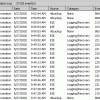Analysis
Articles
 |
Applying Data Analytics to Test Automation Testers gather lots of metrics about defect count, test case execution classification, and test velocity—but this information doesn't necessarily answer questions around product quality or how much money test efforts have saved. Testers can better deliver business value by combining test automation with regression analysis, and using visual analytics tools to process the data and see what patterns emerge. |
|
 |
Rookie Mistakes in Data Analytics It's easy to make simple mistakes in data analysis. But these little mistakes can result in rework, errors, and—in the worst case—incorrect conclusions that lead you down the wrong path. Making small process changes can help you steer clear of these mistakes and end up having a real impact, both in the amount of time you spend and in your results. Here are some tips for avoiding rookie mistakes in data analytics. |
|
 |
Finding the Information inside Your Data Data analysts have to know a lot about diverse business areas so that our reports provide usable information, not just data. We can use this awareness of the value of information to merge different data sets in order to answer new questions, and even help our users make better decisions. But in order to do this, we need to present not just the data, but the information value represented in that data. |
|
 |
Become a Data Detective Rapid changes in data availability and analysis tools are leading to evolving expectations for the data analyst role. We can do much more than just generate reports; we have the opportunity to not only process data, but convert it into understandable information and use the knowledge revealed by our work to help change happen. |
|
 |
7 Ways Monitoring Can Help You Be a Better Tester Monitoring makes your testing work easier, helps you manage certain biases you may have, and lets you learn a lot about the product, users, and even your own processes. Here are seven concrete benefits testers get from monitored data that you can use to convince your team to implement monitoring—as well as realize for yourself. |
|
 |
Reporting Automated Test Results Effectively The modern iterative software development lifecycle has developers checking in code to version control systems frequently, with continuous integration handling building and running automated tests at an almost equally fast rate. This can generate an enormous amount of test data. Here’s how you can ensure you are reporting results effectively across your team and realizing all the benefits of that information. |
|
|
|
Getting Started with Business Intelligence Testing There’s a bit of hype in terms such as business intelligence, data analytics, and data mining. In testing terms, though, it means working with scripts and databases, often without traditional GUI interaction. But core testing skills—analysis, synthesis, modeling, observation, and risk assessment—will still help you go far in business intelligence testing. |
|
 |
Hybrid Verification: Mixing Formal Methods and Testing The ability to verify contracts either statically or dynamically, coupled with recent advances in proof technology, has opened up a new and promising approach to verification. Critical code can be proved with formal methods, and less critical code can be verified using traditional testing, with a clear separation at the interfaces between the two. |
|
 |
Who’s Using Your App? Examine Logs for Testing Insight When testing an application, have you ever thought to yourself, "I wonder who uses this"? Examining the app's logs can give you some idea. Logs are helpful for testers because they provide real feedback and insight into an application as it’s being used, as well as information that describes or can even help solve bugs. Here's how to use them to inform your testing. |
|
 |
IoT, Mobile, and Tech Curve Disillusionment: Moving beyond the Hype The hype around the Internet of Things is at its peak. Should you bother learning the skills developers and testers require in this new field, or will it soon become just another trend that's fallen out of favor? Jon Hagar makes a strong case for why the IoT will be relevant even after the clamor dies down, and why its associated skills will serve you well no matter what. |
Pages
Recommended Web Seminars
| May 23 | How Generative AI Boosts Speed and Quality in Software Testing |
| On Demand | Building Confidence in Your Automation |
| On Demand | Leveraging Open Source Tools for DevSecOps |
| On Demand | Five Reasons Why Agile Isn't Working |
| On Demand | Building a Stellar Team |










